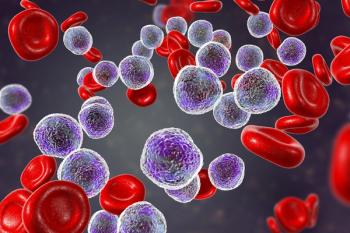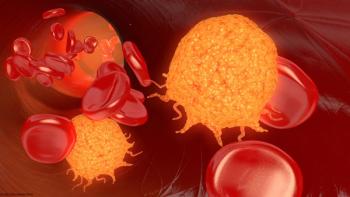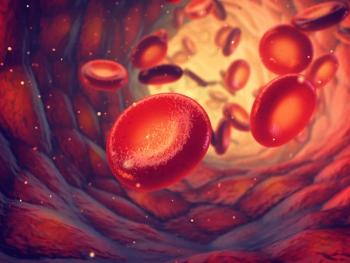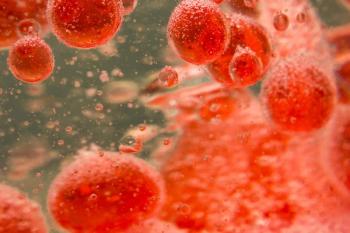
Givastomig Regimen Yields Preliminary Activity in Gastric/GEJ Cancers
Phase 1b data show antitumor activity with the givastomig combination across a wide range of CLDN18.2 expression.
Data from a phase 1b study (NCT04900818) showed early activity in patients with HER2-negative, Claudin 18.2 (CLDN18.2)–positive gastric, esophageal, or gastroesophageal junction adenocarcinoma who received givastomig in combination with nivolumab (Opdivo) plus leucovorin, fluorouracil, and oxaliplatin (mFOLFOX6), according to a presentation at the 2025 ESMO Gastrointestinal Cancers Annual Congress.1
Safety findings from the dose-escalation portion of the trial indicated that when givastomig was given at doses of 5 mg/kg (n = 5), 8 mg/kg (n = 6), and 12 mg/kg (n = 6) in combination with chemoimmunotherapy, it did not lead to dose-limiting toxicities. Grade 3 or higher treatment-emergent adverse effects (AEs) occurred in 65% of evaluable patients (n = 17); 24% of these effects were related to givastomig, and 53% were related to any drug. Treatment-related AEs led to dose interruption for 24% of patients and treatment discontinuation for 12%.
In all 17 patients, the combination elicited an objective response rate (ORR) of 71%. In those with a PD-L1 combined positive score (CPS) of 5 or higher (n = 11), under 5 (n = 6), 1 or higher (n = 15), or under 1 (n = 2), the respective ORRs were 82%, 50%, 73%, and 50%. In those with CLDN18.2 expression of 75% or higher (n = 12), the ORR was 67%; in those with a CLDN18.2 expression below 75%, the ORR was 80%. At a median follow-up of 9.0 months (95% CI, 6.1-11.5), the median duration of response (DOR) was not evaluable (NE; 95% CI, 4.8-NE). The median progression-free survival (PFS) was also NE (95% CI, 4.8-NE), and the 6-month PFS rate was 72.9% (95% CI, 42.6%-89.0%).
“Givastomig appears to be well tolerated at 5 mg/kg, 8 mg/kg, and 12 mg/kg in combination with nivolumab and [chemotherapy], without significant gastrointestinal, hepatic, or immune-related toxicities,” Samuel Klempner, MD, of Massachusetts General Hospital, said in presentation of the data. “Antitumor activity was observed in patients with a wide range of CLDN18.2 expression, as well as low PD-L1 expression.”
Gaining Insights on Givastomig
Givastomig is comprised of a highly potent CLDN18.2 monoclonal antibody that has a higher affinity than zolbetuximab-clzb (Vyloy) and allows for binding to cancer cells with a wide range of CLDN18.2 expression, according to Klempner. The antibody has been engineered to reduce or eliminate the interaction between its Fc region and the immune system. The conditional 4-1BB agonist allows for localized T-cell activation in the tumor microenvironment, which results in strong cancer elimination and minimal 4-1BB–mediated liver toxicity or systemic immune response, he noted.
Previously, single-agent givastomig proved to have favorable tolerability and activity in heavily pretreated patients with CLDN18.2-positive gastric cancer.2 Dose-dependent pharmacokinetics (PK) and induction of soluble 4-1BB have also been observed.
Detailing the Phase 1b Study Design
The multicenter, dose-escalation and -expansion, phase 1b study, which utilized a Bayesian optimal interval design with at least 4 patients per dose, enrolled patients with first-line, unresectable or metastatic gastric cancer, GEJ cancer, or esophageal adenocarcinoma.1 Patients resided in the United States, had HER2-negative disease, and CLDN18.2 expression of 1 or higher on at least 1% of tumor cells. Notably, this was an all-comer PD-L1 population.
In the dose-escalation portion of the research, givastomig was examined at 3 dose levels (DL)—5 mg/kg (DL1), 8 mg/kg (DL2), and 12 mg/kg (DL3)—in combination with 240 mg of nivolumab and mFOLFOX6 given every 2 weeks. The 8- and 12-mg/kg doses of givastomig were selected for further exploration in the dose-expansion phase of the trial, which is intended to include 40 patients. Enrollment for DL2 is complete; enrollment is ongoing for DL3.
The primary end point of the study is safety, and secondary end points include ORR, best overall response, DOR, PFS, overall survival, and PK/pharmacodynamic profile.
Breaking Down the Baseline Patient Characteristics
In the 17 total patients, the median age was 56 years (range, 35-79), and most were female (71%) and White (65%). Regarding ECOG performance status, 53% had a status of 0, and 47% had a status of 1. Most patients had gastric cancer (82%); 12% had GEJ cancer, and 6% had esophageal cancer. Moreover, 71% of patients had CLDN18.2 expression of 75% or higher, 29% had expression below 75%, 82% had expression of 40% or higher, and 18% had expression below 40%. PD-L1 CPS was 1 or higher for 88% of patients and below 1 for 12% of patients. All patients had microsatellite-stable disease.
Extra Efficacy Findings
In those who comprised cohorts selected for expansion (n = 12), the ORR achieved with the regimen was 83%. Within this group, those with a PD-L1 CPS of 5 or higher (n = 9), under 5 (n = 3), 1 or higher (n = 11), and under 1 (n = 1) experienced ORRs of 89%, 67%, 82%, and 100%, respectively. Those with a CLDN18.2 expression of 75% or higher (n = 9) or below 75% (n = 3) had ORRs of 78% and 100%, respectively.
The median follow-up for those in the expansion cohorts was 7.8 months (95% CI, 5.7-10.2), and the median DOR was NE (95% CI, 4.5-NE). The median PFS was also NE (95% CI, 4.5-NE), and the 6-month PFS rate was 81.5% (95% CI, 43.5%-95.1%).
In those with a PD-L1 CPS of 5 or higher and CLDN18.2 expression of 75% or higher (n = 10), the ORR achieved with the regimen was 80%. A patient with a PD-L1 CPS of 5 or higher and CLDN18.2 expression below 75% responded to treatment. Those with a PD-L1 CPS under 5 and CLDN18.2 expression of 75% or higher did not respond to treatment. In those with a PD-L1 CPS below 5 and a CLDN18.2 expression below 75% (n = 4), the ORR was 75%.
Additional Safety Revelations
All patients experienced treatment-emergent AEs, and 88% were determined to be related to givastomig. Serious AEs occurred in 47% of patients, with 12% of cases noted to be related to givastomig. Twelve percent of patients experienced disease progression. No patients experienced treatment-related AEs that proved to be fatal.
The key AEs related to any drug that occurred in at least 10% of patients included peripheral neuropathy (grade ≤2, 59%; grade 3, 0%; grade 4, 0%), nausea (53%; 0%; 0%), neutropenia (35%; 24%; 12%), vomiting (35%; 0%; 0%), infusion-related reaction (35%; 6%; 0%), diarrhea (29%; 0%; 0%), abdominal pain (12%; 6%; 0%), gastritis (6%; 6%; 0%), increased alanine aminotransferase levels (6%; 6%; 0%), and increased aspartate aminotransferase levels (6%; 6%; 0%). The most common immune-related AEs included maculopapular rash (grade ≤2, 12%; grade 3, 0%; grade 4, 0%), pneumonitis (6%; 0%; 0%), and immune nephritis (0%; 6%; 0%).
Disclosures: Klempner disclosed serving as a consultant and/or in an advisory role for Bristol-Myers Squibb, Merck, Astellas, Daiichi-Sankyo, Natera, Novartis, AstraZeneca, Mersana, Sanofi-Aventis, Amgen, Boehringer-Ingelheim, Taiho Oncology, Eisai, BeiGene, Elevation Oncology, EsoBiotec, and Gilead. He is currently participating as an investigator in the presented study.
References
- Klempner SJ, Dayyani F, Kratz J, et al. A phase 1b dose escalation study of givastomig, a CLDN18.2 x 4-1BB bispecific antibody, in combination with immunochemotherapy in HER2-negative, CLDN18.2-positive gastric, esophageal or gastro-esophageal junction adenocarcinoma. Presented at: 2025 ESMO Gastrointestinal Cancers Annual Congress; July 2-5, 2025; Barcelona, Spain. Abstract 388MO.
- Klempner SJ, Shen L, Liu D, et al. Updated safety and efficacy from the phase I study of givastomig, a novel claudin18.2/4-1BB bispecific antibody, in claudin 18.2 positive advanced gastroesophageal carcinoma (GEC). Ann Oncol. 2024;35(suppl 2):S689. doi:10.1016/j.annonc.2024.08.1076
Newsletter
Stay up to date on recent advances in the multidisciplinary approach to cancer.

















































































